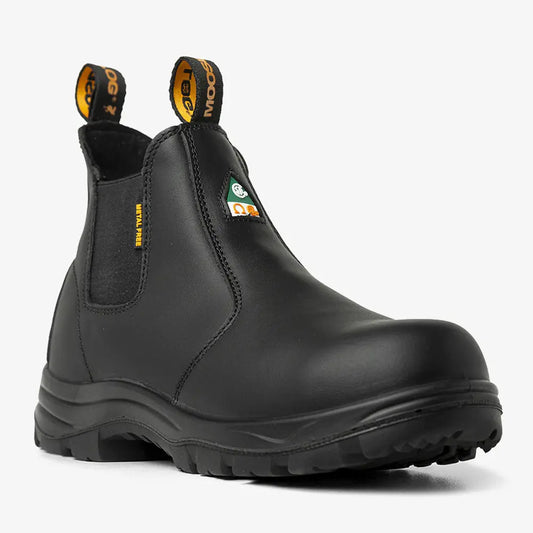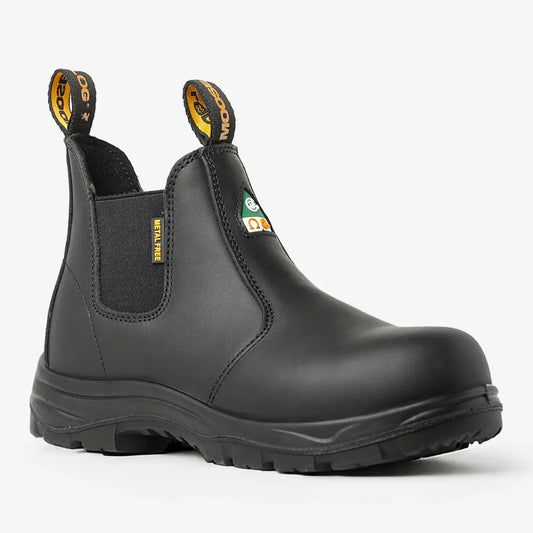
How to Choose the Right CSA Approved Safety Shoes for Work?
CSA Approved Safety Shoes by Job Type
Your job shapes the type of safety shoes you need. Work surfaces, weather, load handling, and safety risks differ across industries. The right footwear supports your movement, reduces strain, and helps prevent avoidable injuries. This guide explains how each job type influences the features you should prioritize when choosing CSA certified boots.
CCOHS – PPE Safety Footwear states that “Impact, compression, and puncture are the most common types of foot injury” and emphasizes matching footwear to hazard. This means choosing the right boot for your job becomes a basic part of staying safe at work.
This guide is written for Canadian trades, service workers, and anyone who relies on proper CSA protection.
Construction and Trades
Construction work involves uneven surfaces, debris, and heavy materials. You lift, climb, and move across unfinished areas. Tasks change through the day which places different loads on your feet.
Key footwear requirements
- CSA green triangle rating
- Composite toe for lighter weight on long shifts
- Puncture protection for nails and scrap metal
- Slip resistant outsole for wet plywood and dust
- Heat resistant outsole for hot surfaces
- Stable ankle support so taller boots with laces
Why this matters
BuildForce Canada reports that construction employment in Canada reached about 1.6 million workers in 2024, a modest increase over 2023, with demand expected to stay elevated as non residential projects and maintenance work continue across the country. With a growing construction market comfortable CSA approved footwear becomes an important part of managing daily strain.
Warehouse and Logistics
Warehouse shifts often involve standing for long periods, repetitive movement, and load handling. Floors are smooth and hard which increases pressure on joints.
Key footwear requirements
- Composite toe for reduced weight
- Slip resistant outsole for polished concrete
- Supportive footbed for extended standing
- Stable midfoot design for repetitive movement
- Breathable upper for indoor temperatures
Workplace insight
Employment in Canada’s transportation and warehousing industry recorded growth this past year, employment rose by 17,000 (+1.6 %) in December 2024. This indicates sustained movement volume in warehousing and logistics, which places added physical stress on workers’ legs and feet.
Landscaping and Groundskeeping
Outdoor work exposes you to uneven terrain, wet grass, slopes, and weather changes. Tools create direct risk to the toe and midfoot.
Key footwear requirements
- CSA green triangle
- Composite toe
- Deep tread slip resistant outsole for grass and inclines
- Water resistant leather
- Durable upper for abrasion
Workplace insight
For landscaping and lawn-maintenance work, uneven ground, debris, tools and wet grass are identified as common causes of slips, trips and falls. The business guide for this industry states that sprains, strains and tears make up nearly half of all injuries in that work. That means footwear with proper traction and support matters for reducing those risks.
Manufacturing and Fabrication
Factories and fabrication facilities vary. You may encounter sparks, chemicals, oils, or sharp material edges. Floors can be wet or dry depending on process type.
Key footwear requirements
- CSA green triangle or white rectangle depending on electrical conditions
- Composite toe
- Oil resistant outsole
- Abrasion resistant leather
- Supportive footbed for standing periods
Workplace insight
According to WorkSafeBC, in British Columbia over the past five years the serious injury rate in manufacturing has been 44% higher than the average across all industries. During that period more than 26,000 manufacturing workers lost time from work due to injury, including over 4,300 serious injury cases.
Utilities and Maintenance
Utility workers face mixed environments. You may climb ladders, handle tools, inspect mechanical rooms, and move between indoor and outdoor areas.
Key footwear requirements
- Composite toe
- Puncture protection
- Aggressive traction pattern
- Electrical hazard rating
- Stable ankle structure
Workplace insight
Utility and maintenance work involves electrical systems, mechanical rooms, outdoor infrastructure, ladders and constant movement between vehicles and job sites. BC Hydro reports that more than 40 percent of work-related injuries and fatalities linked to electrical incidents over the past five years involved contact with live equipment or unsafe conditions. This level of exposure shows how important proper electrical hazard protection and slip resistant footwear becomes for anyone working around energized systems, wet surfaces or metal platforms.
Delivery and Service Roles
Drivers and service technicians move between vehicles, homes, buildings, and outdoor surfaces. Steps are frequent and quick.
Key footwear requirements
- Lightweight composite toe
- Flexible outsole
- Slip resistant tread for sidewalks
- Breathable materials
- Soft cushioning for daily mileage
Workplace insight
WorkSafeBC advises that courier and delivery drivers face frequent transitions between vehicles, sidewalks and building entrances, which increases the chance of slips and strain during daily stops. Their guidance for the courier industry highlights the importance of slip resistant footwear to reduce these incidents. Moving across mixed surfaces all day means footwear that stays light, stable and supportive helps maintain steady footing and reduces fatigue during long routes.
How to Choose Based on Your Job
Your ideal safety shoe depends on three questions.
1. What surfaces do you work on most often?
Different surfaces create different traction demands.
Concrete floors benefit from flat rubber with fine slip resistant patterns.
Grass and soil need deeper lugs that bite into uneven ground.
Metal platforms, ladders and equipment surfaces require aggressive tread that maintains grip when wet or oily.
Plywood and unfinished materials need stable edges and a sole that sheds dust.
2. How long is your shift?
Long shifts increase physical load on the feet, knees and lower back.
Lighter composite toes reduce fatigue over many hours.
Cushioned footbeds support repetitive standing and walking.
Breathable uppers prevent heat buildup in indoor environments.
For outdoor work, insulated or water resistant materials help control temperature and moisture for full day use.
3. What hazards exist in your daily tasks?
Your job determines the protection level you need.
Impact hazards require a certified toe cap with the correct CSA symbol.
Sharp materials mean puncture resistant plates for soles.
Electrical systems call for electric shock protection or dielectric ratings.
Wet floors, oils and outdoor slopes need slip resistant tread with strong rubber compounds.
Tools, machinery and heavy loads increase the importance of stable heel structure and secure midfoot support.
You can explore the full breakdown of CSA symbols, toe types, and testing standards in MooseLog's Ultimate Guide to CSA Safety Shoes.
CONCLUSION

Your job determines the footwear features you should prioritize. CSA approved safety shoes provide tested impact protection, but each workplace has unique demands. When your boot matches your work environment, you move better, feel less strain, and stay safer through your shift. You can explore the full CSA Safety Shoes Info Hub for symbols, testing methods, lightweight protection details, and component breakdowns.
FAQs
Do all CSA approved safety shoes work for any job?
No. Each job has different surface and hazard patterns. Your footwear should match those conditions.
Are composite toes suitable for every job?
Composite toes work for most Canadian job types. They provide strong impact protection with lighter weight.
What CSA rating should I choose for landscaping?
Green triangle boots offer puncture protection and toe impact protection suitable for groundskeeping tasks.
What outsole works best for concrete floors?
Slip resistant rubber designed for smooth surfaces works best for warehouses and logistics.
Can I use one pair of boots for indoor and outdoor work?
Yes. Choose a composite toe with balanced traction and comfortable cushioning.
How long does a CSA boot usually last?
Many workers replace their boots every six to twelve months depending on workload and surface abrasion.




